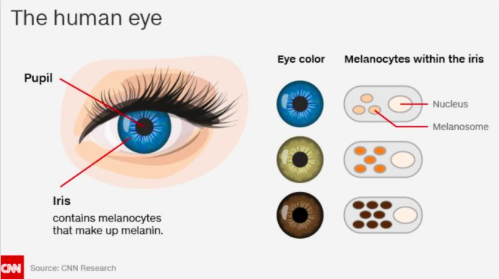
Turns out, everyone — seriously, everyone — has “brown” eyes. You can blame melanin, according to Dr. Gary Heiting, a licensed optometrist and senior editor. You might have known that melanin determines our hair and skin color, but miniature melanin cells, called melanocytes, are found in the iris as well.
Everyone has melanin in the iris of their eye, and the amount that they have determines their eye color.
The shocker: There’s really only one “shade” of melanin — and it’s brown! The more melanocytes in your iris, the darker your eye color.
Light is also a factor: Melanin absorbs light, so the more melanin there is, the less light will be absorbed. Brown-eyed people have more melanin, less light.

The opposite is true for people with “blue” eyes. Those with less melanocytes can’t absorb as much light, so more light is reflected back out of the eye. This is called scattering — and when light is scattered, it reflects back at shorter wavelengths. On the color spectrum, shorter light wavelengths correspond with the color — you guessed it — blue.
As for green and hazel-eyed folks — well, you are the Goldi locks of eye color. You don’t have too much melanin, nor do you have too little. You’re somewhere in the middle. Has anyone ever told you that your eyes seem to change color? That’s because your color is much more responsive to your “light” environment. Your eyes probably look different when it’s sunny outside versus when it’s dark and stormy.
This all explains why babies’ eyes appear blue right after birth — their melanin is still forming and may darken over time. “As a baby develops, more melanin accumulates in the iris,” said Heiting. But a lot goes into melanin — eye color is a polygenic trait, which means that multiple genes determine it. That’s why dark-eyed parents can produce light-eyed children.
Pretty neat.
